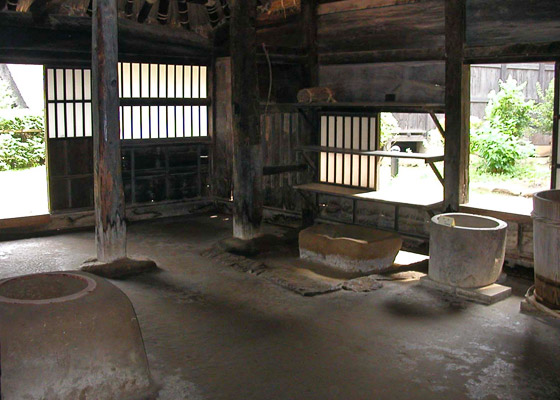|
||
 |
||
2 In the ancient period, niwa was the space in front of the steps of the principal hall in an aristocratic or imperial residence, shrine or temple. This space was essentially ceremonial, and was used for religious festivals and the ritual aspects of government, matsurigoto 祭事. It was often surfaced with sand or raked gravel, and usually defined by fences *kaki 垣, walls *hei 塀, a cloister *kairou 回廊, or other buildings. See *nakaniwa 中庭 courtyard.
3 In the residences of the aristocracy and later in the grounds of temples, an ornamental park or garden. Termed shima 島 in the Asuka and Nara prefectures, and sono 園 from the mid Heian period. It was characterized by man-made mounds or hillocks, pools, islets, streams, waterfalls, paths and areas of gravel or sand enlivened with carefully chosen rocks. Landscaping was supplemented by planting of trees, bamboo, shrubs, flowers and moss. It was to denote this kind of niwa that the Chinese character 庭 was apparently adopted. These gardens had ritual and religious aspects, for example a garden like that of the 11c Byoudouin 平等院 was intended to evoke on earth the splendours of the Pure Land gokuraku joudo 極楽浄土, *Amida's 阿弥陀 Western Paradise. However, its principal functions were increasingly recreational as it catered to the leisure time pursuits of a highly sophisticated aristocracy. Especially in the Edo period, the ornamental garden spread with the shoin and sukiya architectural styles ; *shoin-zukuri 書院造 and *sukiya-zukuri 数奇屋造 to vernacular houses *minka 民家. A wide variety of different types and styles of niwa developed, such as the very small tsuboniwa 坪庭 often found in urban houses.
4 In farmhouses nouka 農家, the yard or area immediately in front of the main house, used principally as an agricultural workspace nousagyouba 農作業場, for threshing rice, drying vegetables etc. It had ritual uses too, for in certain areas, it constituted the main approach to the house, also termed kado 門. Pine trees called kadomatsu 門松 were placed here to greet the gods at New Year. Torches called mukaebi 迎え火 and okuribi 送り火 lighted the path of the returning ancestors or Buddhas at the annual Bon 盆 festival. The niwa was referred to in Ehime prefeture as hirunuwa ひるぬわ, and in Gifu prefecture as hinoriba ひのりば or hiruniwa 昼庭, indicating that it was used for work during the hours of daylight. Also called maeniwa 前庭, sotoniwa 外庭, hoshiniwa 干庭, tsubomae 坪前 and tsubo 坪.
5 An external working space, sagyouba 作業場, or yard used for any craft or proto-industrial process.
6 An alternative term for the working space within the houses of farmers, fishermen and urban artisans. In many cases this area was synonymous with the earth-floored area *doma 土間, which also contained the cooking stove *kamado 竃 and domestic cooking facilities. In certain parts of Aomori prefecture and the Hida 飛騨 district of Gifu prefecture the internal niwa was provided with a raised floor of timber *itaniwa 板庭, usually one step lower than the other raised floor living rooms *ima 居間 (kyoshitsubu 居室部). The interior niwa permitted work to continue in bad weather, after dark, particularly in the mountainous areas and in Touhoku 東北 region during winter. Also referred to in farmhouses as *usuniwa 臼庭, after the mortar or hand mill, usu 臼, used for pounding rice which was often kept and used there. In townsmen's houses *machiya 町家, the niwa was often smaller than in farmhouses and took the form of a narrow 'passing yard' *tooriniwa 通り庭, so called because it gave access to the rear of the plot.

Old Emukai 江向 house
Original Location : Toyama prefecture
Nihon Minka-En 日本民家園 in Kawasaki (Kanagawa)
(C)2001 Japanese Architecture and Art Net Users System. No reproduction or republication without written permission.
掲載のテキスト・写真・イラストなど、全てのコンテンツの無断複製・転載を禁じます。

